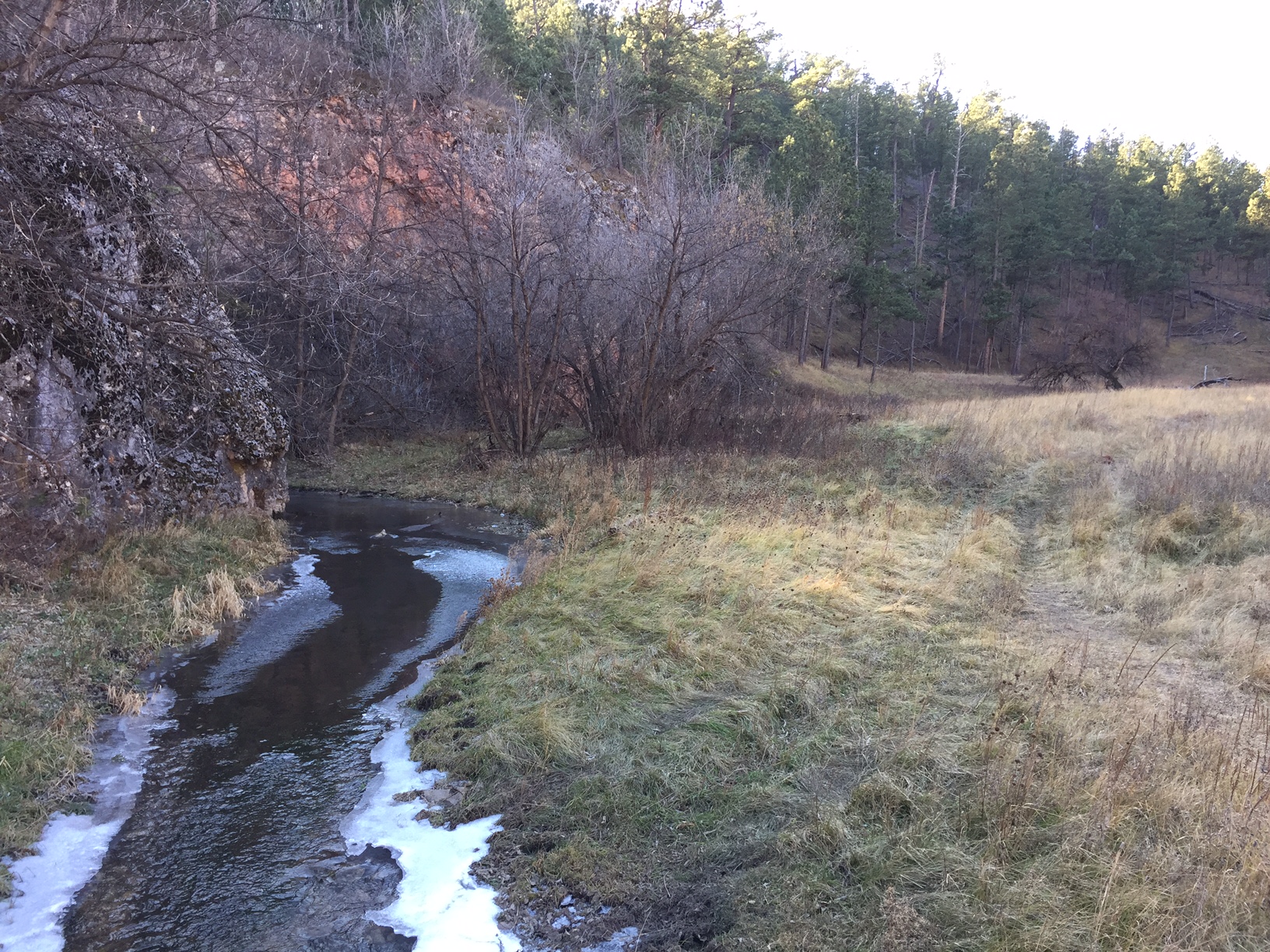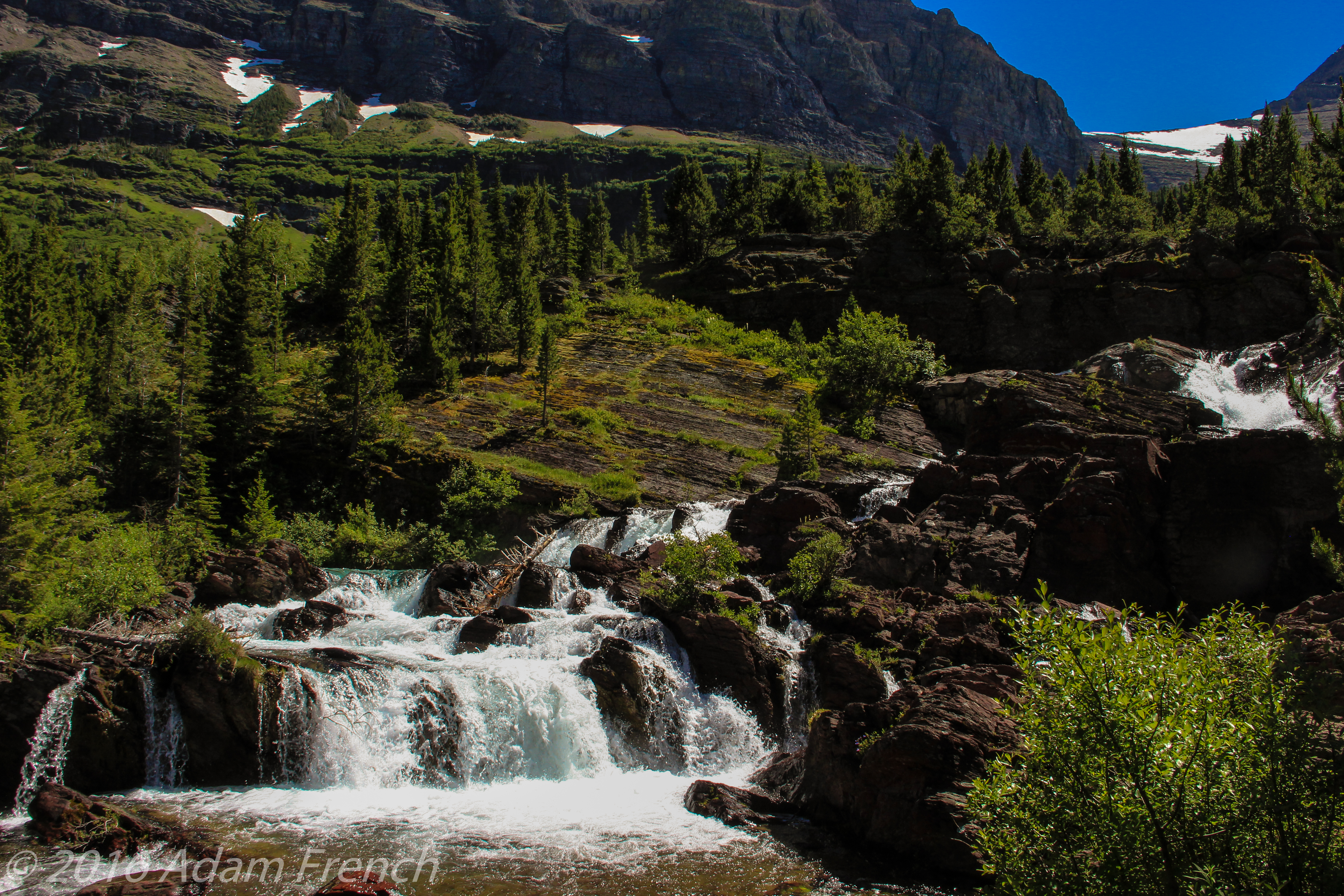Big Hill is a recreation area located in the Black Hills National Forest that offers outdoor, leisure opportunities year-round. The prime activities enjoyed here are cross-country skiing, snowshoeing, and fat-biking in the winter, though people regularly hike and mountain bike here during the summer months, as well.
Where is Big Hill?
The Big Hill recreation area is located southwest of Spearfish, in the northern Black Hills. The easiest way to reach the main trailhead is to take Exit 8, off of I-90, for McGuigan Road. Take this south until you reach the T-intersection with Tinton Road. Turn right at the intersection to drive up the hill.
After about 8 miles, watch for a VERY tiny brown sign on the right-hand side of the road showing a hiker. Shortly after this sign, at the top of the hill, you’ll see a large parking area on your right. (The trailhead is directly across the road from the parking area). It is difficult to miss as there are usually numerous other cars there (especially in the winter).
There are other routes you can take to reach this trailhead–coming from downtown Spearfish–as well as a scenic route coming up the other direction on Tinton Road from the south (from Roughlock Falls Road). While this is a beautiful, scenic drive that I highly recommend in the summer, it should be approached with extreme caution in the winter. This portion of the road is barely maintained for winter driving and is usually at least somewhat snow-covered. We have successfully taken this route in the 4×4 truck in the winter, but it’s not for the faint of heart (though it is necessary if you want to reach the Old Baldy trailhead to enjoy winter activities in that area).
The route from McGuigan Road to the trailhead is usually maintained quite well and can often be reached using a typical, 2-wheel drive vehicle (we made our first trip there in an old Civic). It should also be noted that whether Summer or Winter, all of these dirt/gravel forest roads are dependent on the current weather and their condition can vary greatly (and QUICKLY) as the weather changes.
What is the Big Hill Recreation Area like?
Big Hill offers over 15 miles of trails formed by several different loops/routes (many follow old forest roads) that can be combined in a variety of ways. Trail maps are usually available at the trailhead.
The trails at Big Hill are very well-signed but it’s still best to have a map to help determine the best route for you (the map also indicates the difficulty levels of the various trails). The managers of this recreation area also do a marvelous job of keeping the ski trails and the snowshoe/fat bike/dog-friendly trails separate while ensuring everyone can still enjoy this beautiful area!
Big Hill tends to be one of the snowier places in the Black Hills so you can potentially participate in winter activities here anywhere from October – May (dependent on current snow conditions, of course). We’ve enjoyed snowshoeing here, as well, though there are times the snow isn’t quite deep enough so we tend to favor the Eagle Cliff area for our snowshoeing adventures.
Today, I am focusing on the winter sports available here. I will say though, this area is a must-see in the fall when the yellow Aspens are in full color.

**I mentioned the Eagle Cliff area above. It only has one groomed trail, the rest are just trails cut by outdoor enthusiasts. Big Hill offers machine-groomed ski trails that are better for practicing the fundamental drills of skiing as they are smoother.
Machine-groomed trails require FAR less effort, but I find I enjoy them less. They are more crowded and while faster, I find it’s harder to control my skis. The person-groomed trails require more effort and you’ll move less quickly, but I find the resistance the snow provides aides in control of the skis and balance. So, while the groomed trails are usually recommended for beginners, I’d say you have to decide what is most important to you; ease of effort or less fear of hurtling down a hill uncontrollably…possibly towards a tree. 😳
Warmer the higher up you go?
This area is another example of the complicated, frequently-contrasting weather you can have in the Black Hills. On several occasions we’ve experienced temps in the single digits to low teens in the lower elevations–but it can feel almost balmy with temps in the mid-twenties at Big Hill (that equates to perfectly comfortable conditions when skiing, in the sun, with little wind.) This contrasting weather is due to a temperature inversion. Put in simple terms this basically means warmer air is lighter and floats over cooler air. This makes it warmer the higher you go in elevation. (If you want a more scientific explanation you’ll have to track down Mr. Trekker. 😃)
Snowshoeing vs. Cross-Country Skiing
Snowshoeing is great fun, but it’s HARD work depending on snow conditions (this activity and mountain biking are literally the hardest workouts I’ve ever done).
Cross-country skiing, in contrast, requires far less exertion (and I’ve found that working out with an elliptical during the week is perfect training for this sport as the body motions required for both are very similar).
Anyone who can walk can snowshoe. It takes a little skill to keep from stepping on your own shoes, but once you master that, you’re golden. Cross-country skiing, on the other hand, is FAR more difficult. It requires balance, finesse, and the ability to relax and just “go with the flow”–all characteristics I SORELY lack (“sore” being the keyword as that’s often the result of my endeavors 😝).
I would also argue skiing is more dangerous as you’re moving faster and are more likely to slip/twist something when you fall (and you WILL fall). If you fall while snowshoeing, you pretty much just end up on your rump or fall to the side into a cushioning snowbank. It may be cold, but not really injury-inducing (although your snowshoe could become stuck under a buried log, as I found out at Big Hill one early, spring day…😮 )
We’ve gotten pretty good at most outdoor sports we enjoy, but with skiing, we’re still very much beginners. Standing on a thin object that’s meant to glide quickly and effortlessly does not lend itself to keeping one’s balance. Neither do skis that are as long as I am tall and stick out several feet both in front of and behind you. Not only do you have to learn how to move around without stepping on yourself (similar to snowshoes) but you have to do it while each leg is trying to slide in an opposite direction. 😝
So, if you’re enjoying a snowy weekend at Big Hill, and you see a bumbling idiot barely able to stay upright on their skis..it just might be me! 😇
The best trails at Big Hill
 For beginners, I strongly recommend starting with the initial Loop A. It’s a short, groomed trail that just goes in a small circle around a meadow/forested area near the front of the Big Hill trail network. It’s fairly flat with only a few short rises and dips and doesn’t offer much opportunity for falls (though, full disclosure, I have fallen here 😝).
For beginners, I strongly recommend starting with the initial Loop A. It’s a short, groomed trail that just goes in a small circle around a meadow/forested area near the front of the Big Hill trail network. It’s fairly flat with only a few short rises and dips and doesn’t offer much opportunity for falls (though, full disclosure, I have fallen here 😝).
There is another Loop A that goes farther out. This option is also usually groomed. It’s also good for beginners once you get a little more confidence as it’s solely a “green” route–meaning it’s considered “easy”. There are a few steeper slopes, one especially on the right-hand (western) side of the loop as you’re heading out. I’ve had my worst spills in this area and though they were frightening, I’ve left without injury–so far–and haven’t even felt very sore the next day. (A surprise as I was sure my ankles were being ripped from my body when I fell. 😮 )
What will you see at Big Hill?
Big Hill is absolutely BEAUTIFUL no matter the time of year. It offers a mixture of forested and meadowy areas that contain leafless deciduous and evergreen trees, all covered in a soft blanket of snow during the winter. On sunny days you’ll frequently hear birds chirping in the trees, and the ever-present, South Dakota breeze rustling through the pines provides a respite from the deafening, snowy silence. In the fall, this area offers a warm glow with the bronze meadowgrass, and glowing, yellow aspens all standing in contrast to the evergreen trees.

This recreation area is far enough from civilization that it offers an incredibly peaceful environment. It is sullied in the winter only by the occasional roar of snowmobiles that also enjoy nearby trails–though not these exact trails. (Fortunately, they focus on the region on the other side of the road so they are usually only really heard when you are near the parking lot.)
If you’re looking for a great place to enjoy some snow sports that is both beautiful, easy to reach, and that offers fun options for everyone, check out Big Hill!
Have you tried the Big Hill Recreation Area? Tell me about your experience in the comments!
Did you enjoy reading this post? Pin it!

Like what you read here today? Please feel free to leave a comment, like or share this post! Add your email at the bottom of the page, or the sidebar to the right, to be notified when a new post is published. By signing up for the email list, you will also receive a free copy of the Tranquil Trekker’s Top 10 Tips of Trekking Do’s and Don’ts!
You can also follow the blog on social media by clicking the links below!
Facebook
Twitter
Instagram
Pinterest








 For beginners, I strongly recommend starting with the initial Loop A. It’s a short, groomed trail that just goes in a small circle around a meadow/forested area near the front of the Big Hill trail network. It’s fairly flat with only a few short rises and dips and doesn’t offer much opportunity for falls (though, full disclosure, I have fallen here 😝).
For beginners, I strongly recommend starting with the initial Loop A. It’s a short, groomed trail that just goes in a small circle around a meadow/forested area near the front of the Big Hill trail network. It’s fairly flat with only a few short rises and dips and doesn’t offer much opportunity for falls (though, full disclosure, I have fallen here 😝). 













































